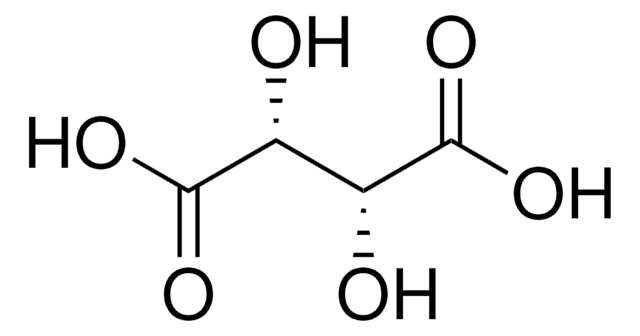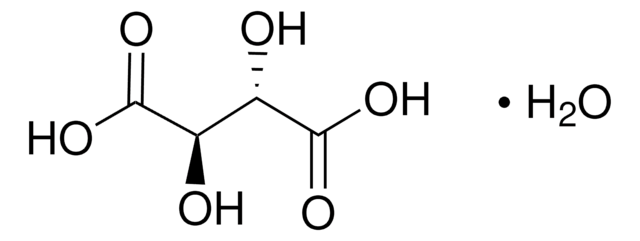모든 사진(4)
About This Item
Linear Formula:
HO2CCH(OH)CH(OH)CO2H
CAS Number:
Molecular Weight:
150.09
Beilstein:
1725147
EC Number:
MDL number:
UNSPSC 코드:
12352209
PubChem Substance ID:
NACRES:
NA.26
추천 제품
vapor density
5.18 (vs air)
Quality Level
제품 라인
BioXtra
분석
≥98%
형태
powder
autoignition temp.
797 °F
불순물
≤0.002% Phosphorus (P)
≤0.1% Insoluble matter
무기 잔류물
≤0.1%
mp
170-172 °C (lit.)
solubility
H2O: 1 M at 20 °C, clear, colorless
음이온 미량물
chloride (Cl-): ≤0.05%
sulfate (SO42-): ≤0.05%
양이온 미량물
Al: ≤0.002%
Ca: ≤0.005%
Cu: ≤0.0005%
Fe: ≤0.005%
K: ≤0.005%
Mg: ≤0.001%
NH4+: ≤0.05%
Na: ≤0.005%
Pb: ≤0.001%
Zn: ≤0.0005%
SMILES string
O[C@H]([C@@H](O)C(O)=O)C(O)=O
InChI
1S/C4H6O6/c5-1(3(7)8)2(6)4(9)10/h1-2,5-6H,(H,7,8)(H,9,10)/t1-,2-/m1/s1
InChI key
FEWJPZIEWOKRBE-JCYAYHJZSA-N
유사한 제품을 찾으십니까? 방문 제품 비교 안내
일반 설명
Tartaric acid is a dicarboxylic acid and occurs as two enantiomers and an achiral meso compound. The L-(+)-tartaric acid is extensively found in nature. It is an acid present in fruits such as grapes and bananas. It possesses an astringent and citrus flavor.
애플리케이션
L-(+)-Tartaric acid has been used:
- in filter-sterilized synthetic grape juice for feast fermentation
- in crystallization experiment
- to test the influence of stereospecific interactions between stereoisomers of tartaric acid and proteins during crystallogenesis
생화학적/생리학적 작용
L-(+)-Tartaric acid serves as a donor ligand for biological processes. It is used as a food additive in candies and soft drinks to impart a sour taste.
신호어
Danger
유해 및 위험 성명서
예방조치 성명서
Hazard Classifications
Eye Dam. 1
Storage Class Code
11 - Combustible Solids
WGK
WGK 1
Flash Point (°F)
302.0 °F - closed cup
Flash Point (°C)
150 °C - closed cup
개인 보호 장비
dust mask type N95 (US), Eyeshields, Gloves
이미 열람한 고객
Acetogenin (Polypriopionate) Derived Auxiliaries: Tartaric Acid
Comprehensive Chirality (2012)
4.16-human-environment interactions?Taste
Izawa K, et al.
Comprehensive Natural Products II, 631-671 (2010)
Higher Denticity Ligands
Comprehensive Coordination Chemistry II (2003)
Effects of protein purity and precipitant stereochemistry on the crystallization of thaumatin
Asherie N, et al.
Crystal Growth & Design, 8(12), 4200-4207 (2008)
Nina Piggott et al.
G3 (Bethesda, Md.), 1(5), 353-367 (2012-03-03)
The ability of cells to respond to environmental changes and adapt their metabolism enables cell survival under stressful conditions. The budding yeast Saccharomyces cerevisiae (S. cerevisiae) is particularly well adapted to the harsh conditions of anaerobic wine fermentation. However, S.
자사의 과학자팀은 생명 과학, 재료 과학, 화학 합성, 크로마토그래피, 분석 및 기타 많은 영역을 포함한 모든 과학 분야에 경험이 있습니다..
고객지원팀으로 연락바랍니다.





